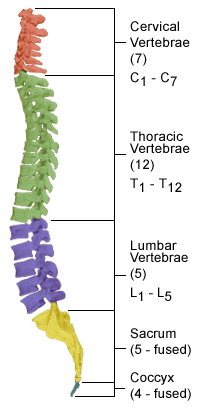How Are the Neck and Spine Related?
 A lot of us think of the neck and spine as separate, but, in fact, together they form a continuous structure that supports, protects, and enables movement and nerve function throughout the body.
A lot of us think of the neck and spine as separate, but, in fact, together they form a continuous structure that supports, protects, and enables movement and nerve function throughout the body.
The neck houses the uppermost portion of the vertebral column, the cervical spine. It consists of seven vertebrae (C1 to C7). These vertebrae support the skull, protect the spinal cord, and allow a wide range of head and neck movements.
The spine, including the cervical portion in the neck, supports the body’s weight, maintains posture, and facilitates movement. The cervical spine specifically allows for the rotation, flexion, extension, and lateral bending of the head and neck.
The spinal cord, which runs through the vertebral column, extends from the brain down through the neck and into the lower back. Nerves branching off from the cervical spine control motor and sensory functions in the upper body, including the shoulders, arms, and hands.
Any issues in the cervical spine, such as misalignment, injury, or degeneration, can affect its overall function and lead to symptoms like pain, stiffness, or neurological deficits in other parts of the body.
To understand the interdependence of the neck and spine in more detail, consider these key points:
Movement Coordination:
- Movements of the neck, such as turning the head, bending, or extending, are coordinated with the movements of the entire spine. For instance, turning the head to look to the side involves not just the cervical spine but also the thoracic spine to some extent.
- Movements of the lower spine also affect the cervical spine. For example, poor posture in the lumbar region (like slouching) can lead to compensatory adjustments in the cervical spine, causing neck pain or strain.
Neurological Function:
- The cervical spine houses the upper part of the spinal cord, which transmits nerve signals between the brain and the rest of the body. Nerves that originate from the cervical spine innervate the upper limbs, neck, and shoulders.
- The spinal cord runs through the entire spine, connecting with various nerves along the way. Issues in the cervical spine can affect nerve function throughout the body, potentially leading to symptoms in other regions, such as numbness, tingling, or weakness in the arms or legs.
Injury and Compensation:
- An injury or degeneration in the cervical spine can lead to changes in the way the rest of the spine functions. For example, if a person has a herniated disc in the cervical spine, they may alter their posture or movement patterns to avoid pain, which can put extra strain on the lower spine.
- Conditions like scoliosis or kyphosis (curvature of the spine) in the thoracic or lumbar regions can affect the cervical spine by altering the body’s overall alignment and biomechanics, leading to neck pain or discomfort.
Postural Influence:
- The position of the head and neck affects the alignment of the entire spine. Forward head posture, for instance, can lead to increased stress on the cervical spine and contribute to problems like headaches or neck pain.
- The alignment of the thoracic and lumbar spine influences the cervical spine’s position. Poor posture or spinal deformities in the lower back can cause the cervical spine to compensate, potentially leading to discomfort or dysfunction.
The neck and spine are deeply interconnected, with each influencing the other’s health, function, and movement. Issues in one part of this system can have cascading effects throughout the body, highlighting their interdependence. So, when you think about spine health, don’t forget to include your neck!
